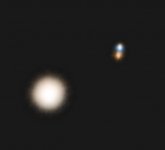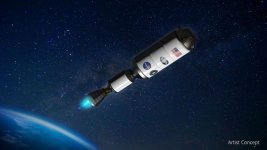As a moderately competent Particle Physicist, familiar with Quarks and all that, alarm bells were raised by recent events in the Dark Universe:

https://www.birminghammail.co.uk/whats-on/shopping/mums-outrage-over-50-smyths-15507979
Clearly Mum has little understanding of Science and Telescopes. But I find Smyths siingularly lascking in their treatment of a kid who is, doubttess, a Star-Child.
I think Smyth missed an opportunity here. They could have made a kind Christmassy gesture. 🙄
https://www.birminghammail.co.uk/whats-on/shopping/mums-outrage-over-50-smyths-15507979
Clearly Mum has little understanding of Science and Telescopes. But I find Smyths siingularly lascking in their treatment of a kid who is, doubttess, a Star-Child.
I think Smyth missed an opportunity here. They could have made a kind Christmassy gesture. 🙄
I suspect the mistake she made was fitting the highest power eyepiece and a X2 barlow lens extension.
These toy telescopes still need careful aligning of the finder scope because the field of view is tiny, and fucus hard to find at high power.
Best practised in daylight on a distant object. Realistically they only work well with low power. Tripod is plasticcy and wobbly too, but not the same fitting as a better camera tripod.
These toy telescopes still need careful aligning of the finder scope because the field of view is tiny, and fucus hard to find at high power.
Best practised in daylight on a distant object. Realistically they only work well with low power. Tripod is plasticcy and wobbly too, but not the same fitting as a better camera tripod.
Yes, starting the observations on high power magnification instead of on low power was my other, less amusing explanation of their difficulties.
My boyhood Charles Frank Junior Astronomical Telescope had a fixed magnification of 30 X, making it a much easier tool for a budding "Star-Child" to get to grips with.

Focussing was achieved simply by sliding the tube containing the eyepiece lens back and forth inside the tube containing the objective lens.
My boyhood Charles Frank Junior Astronomical Telescope had a fixed magnification of 30 X, making it a much easier tool for a budding "Star-Child" to get to grips with.
Focussing was achieved simply by sliding the tube containing the eyepiece lens back and forth inside the tube containing the objective lens.
the field of view is tiny
A contractor 'transit' (limited theodolite) is often 22 power, and while you may be able to find the broad side of a barn, finding a hand-size rod marker across a field can be very difficult. I put a 2-foot yellow target 500 feet away through my woods and I had a heck of a time lining up on it. Add in elevation and I can see how it could be hard to find the moon, and Mars impossible.
Here is my Craftsman "Farm Level" (or one much like it).

well as well as being pretty rubbish and drifting off as soon as you even get close to them the big problem with the average 4 year old and a telescope (or bins) is that they can't work out how to use the eyepieces properly. I've tried and failed many times (having had quite a few 4 year olds pass through over the last 20 years.
Yes indeed PRR, even 'spotting' the Moon with a starter telescope can be problematical, as a tiny change in aim will move the image massively.
I can appreciate, billshurv, that a young child would not know 'how to look' through a telescope. Also, if their eye touches the eyepiece the image will not be stable.
However, there could well have been a collimation problem with little Billy's telescope, e.g., a lens which is out of physical alignment, which would result in a focussing problem.
I can appreciate, billshurv, that a young child would not know 'how to look' through a telescope. Also, if their eye touches the eyepiece the image will not be stable.
However, there could well have been a collimation problem with little Billy's telescope, e.g., a lens which is out of physical alignment, which would result in a focussing problem.
The last Apollo astronaut, Walter Cunningham of the illness affected Apollo 7 has died, age 90.
Aw Bless! https://www.bbc.co.uk/news/world-us-canada-64159514
I was stumbling around in the darkness tonight, and have managed to see the moons of Jupiter!
I saw the craters of the moon the other night at x18 magnification on my toy telescope.
It was quite hard to get it pointed right, being only 2 degrees field of view. But not too wobbly.
Two each side as predicted, and a good tool this:
https://skyandtelescope.org/observing/jupiters-moons-javascript-utility/#

They move quite a lot from night to night.
More excitement, the UK launches it first Virgin Galactic space rocket from Newquay, Cornwall tonight around 10 PM:
https://www.bbc.co.uk/news/science-environment-64190848
It is 21 tons and as long as two Double Decker buses! 😀
Aw Bless! https://www.bbc.co.uk/news/world-us-canada-64159514
I was stumbling around in the darkness tonight, and have managed to see the moons of Jupiter!
I saw the craters of the moon the other night at x18 magnification on my toy telescope.
It was quite hard to get it pointed right, being only 2 degrees field of view. But not too wobbly.
Two each side as predicted, and a good tool this:
https://skyandtelescope.org/observing/jupiters-moons-javascript-utility/#
They move quite a lot from night to night.
More excitement, the UK launches it first Virgin Galactic space rocket from Newquay, Cornwall tonight around 10 PM:
https://www.bbc.co.uk/news/science-environment-64190848
It is 21 tons and as long as two Double Decker buses! 😀
Nice to hear from you Steve! I was beginning to get worried by your absence.
The One Show is on telly in the background and currently Dr. Maggie Aderin-Pocock is commenting on the imminent Cornwall launch.
The One Show is on telly in the background and currently Dr. Maggie Aderin-Pocock is commenting on the imminent Cornwall launch.
A deep disappointment to Scientists in the UK!
https://www.bbc.co.uk/news/science-environment-64223882
OK, it was insured... but time has been lost.
A failure (or anomoly) in this American rocket second stage:

Who designed the second stage? Not me, that's for sure. 🙄
Best Regards from Steve in Spaceport Portsmouth, UK.
https://www.bbc.co.uk/news/science-environment-64223882
OK, it was insured... but time has been lost.
A failure (or anomoly) in this American rocket second stage:
Who designed the second stage? Not me, that's for sure. 🙄
Best Regards from Steve in Spaceport Portsmouth, UK.
Attachments
Last edited:
That's a comprehensive link, Steve.
It seems the second stage rocket burned for the required length of time, but just not powerfully enough.
As the link says, the rocket failure is a setback, not a roadblock.
It seems the second stage rocket burned for the required length of time, but just not powerfully enough.
As the link says, the rocket failure is a setback, not a roadblock.
Since this thread is as close to a NASA appreciation fora as possible, and as the YT algorithm once again delivered me something wonderful, I thought others might enjoy -one of Destin’s several interviews with Luke Tulley. There’s another name if y’all wanna stumble upon a Google / You Tube rabbit hole. Luke has gotta be in his late ‘70s or more, and keeps this all in his head - meanwhile I can’t remember what I had for dinner two days ago.
Oh, and Destin visiting his dad at work:
Oh, and Destin visiting his dad at work:
Member
Joined 2009
Paid Member
- meanwhile I can’t remember what I had for dinner two days ago.
oh that's easy, I just look in the fridge...
In this household, we follow the adventures of NASA! Why even my facebook regularly suggests articles about NASA and the JWST!
Why? I don't know... it's just Google doing its spyware thing....
Latest interest on Moons is the Juno mission, which is getting better images of Jupiter's moons than my toy telescope:

Looks a lively Moon to visit. Heated by tidal forces. Europa and Ganymede are chock full of water.and ice.
The orbital mechanics employed by the space probe are extremely interesting too. This a good article.
https://www.bbc.co.uk/news/science-environment-63982190
I am brushing up on the subject:

Tidal forces, Lagrange points, Chaotic orbits. Very interesting. 😎
Why? I don't know... it's just Google doing its spyware thing....
Latest interest on Moons is the Juno mission, which is getting better images of Jupiter's moons than my toy telescope:
Looks a lively Moon to visit. Heated by tidal forces. Europa and Ganymede are chock full of water.and ice.
The orbital mechanics employed by the space probe are extremely interesting too. This a good article.
https://www.bbc.co.uk/news/science-environment-63982190
I am brushing up on the subject:
Tidal forces, Lagrange points, Chaotic orbits. Very interesting. 😎
[Io] Looks a lively Moon to visit.
As your link says, Steve, Io is the most volcanic body in the solar system, with hundreds of active volcanoes.
And it turns out those volcanoes also help make Jupiter the most powerful particle accelerator in the Solar System!
Particles of material ejected from the volcanoes on Io become charged by the adundance of electrons, protons and ions surrounding Jupiter.
The charged particles are then accelerated up to millions of miles per hour by Jupiter's strong and rotating magnetic field, and an electric circuit is created between Io and Jupiter.
The image shows Jupiter's aurora, taken it ultraviolet light by Hubble. The very bright spot or "auroral footprint" on the left shows where electric currents from Io rain down on Jupiter's upper atmosphere.
In 2018, while closing in on Jupiter for its 12th time, NASA’s Juno spacecraft flew very near the "electric circuit" between Io and Jupiter and detected the particle flux between the two bodies. The full story is here: https://www.jhuapl.edu/NewsStory/210215-Io-helps-Jupiter-accelerate-particles
TBH, i lose track of all the events in the Universe sometimes...
But i clearly made a schoolboy error in assuming all the Apollo Astronauts were dead:

https://www.bbc.co.uk/news/world-us-canada-64359316
Good luck to you, Buzz Aldrin! Hard to believe that Anca Faur is 63! She looks 16. Must be a Relativistic Effect. 🙂
But i clearly made a schoolboy error in assuming all the Apollo Astronauts were dead:
https://www.bbc.co.uk/news/world-us-canada-64359316
Good luck to you, Buzz Aldrin! Hard to believe that Anca Faur is 63! She looks 16. Must be a Relativistic Effect. 🙂
Member
Joined 2009
Paid Member
NASA to test nuclear thermal rocket engine for the first time in 50 years
https://www.cnn.com/2023/01/24/world/nasa-nuclear-thermal-rocket-engine-mars-scn/index.html
Attachments
- Home
- Member Areas
- The Lounge
- Artemis - the NASA mission


